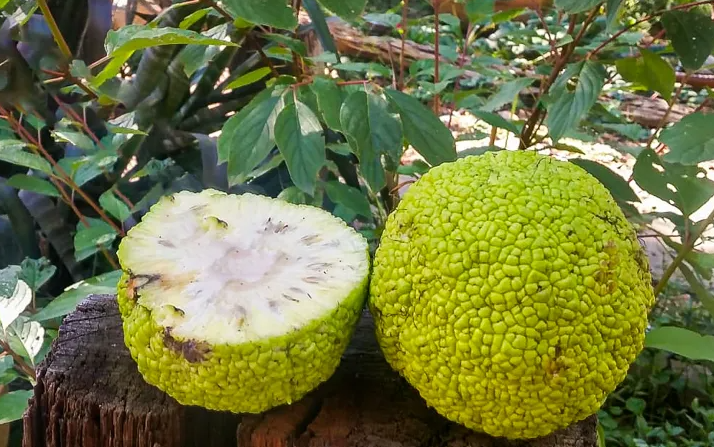
History
The Osage orange (Maclura pomifera), also called horse apple, hedge apple, bodark and bois d’arc has very dense, rot-resistant wood that excretes a milky sap. The branches are armed with thorns at leaf bases. Osage orange fruit is green, bumpy and inedible.
The story of the Osage Orange, or Maclura pomifera, begins in the rich, fertile soils of the Red River valley between Oklahoma, Texas, and Arkansas, where it was native long before European settlers arrived. This tree, named for the Osage Indians who found its wood ideal for crafting bows, quickly became intertwined with the history of American expansion. The Osage Nation, among other tribes, valued the tree not only for its durable wood but also for its symbolic and practical uses in their culture, where the strength and resilience of the wood mirrored the qualities they esteemed.
As settlers moved westward in the 19th century, the Osage Orange found a new role. Its thorny branches made it an excellent candidate for natural fencing. Before the widespread use of barbed wire, farmers planted Osage Orange in tight rows to create living fences or “hedgerows” that were “horse-high, bull-strong, and hog-tight.” This use was so prevalent that it led to one of its nicknames, “hedge apple.” In fact, the thorns on their zigzagging branches served as the basis for the invention of barbed wire.
Characteristics and facts
The osage-orange (Maclura pomifera) is prized across U.S. Department of Agriculture plant hardiness zones 5 through 9 for its dense canopy, attractive foliage and bark, strong wood and unique fruits. When fully grown, an Osage Orange tree can reach heights of about 26 to 49 feet. In optimal conditions, some specimens might grow even taller, but this is less common.
The spread or canopy width of the tree can be quite broad if not pruned, often matching or even exceeding its height, leading to a spread of 20 to 40 feet. The fruit which is perhaps its most distinctive feature, is large, typically 10 to 13 cm in diameter, roughly the size of a grapefruit, and can weigh up to a pound or more. These fruits are not true oranges but have a rough, brain-like texture.
The trunk can grow to a substantial diameter, often reaching about 3 feet or slightly more in older trees. The bark is deeply furrowed and has an orange-brown color, which contributes to its name. The growth rate is moderate. Under good conditions, it might grow 1 to 2 feet per year, though this can vary with soil quality, water availability, and climate. The leaves are simple, ovate to lanceolate in shape, meaning they are broadest near the base and taper to a point at the tip. In the fall, they turn a bright yellow before dropping.
The tree is dioecious, meaning that male flowers appear on some trees, while others produce only female flowers. Both types produce small, green, inconspicuous blooms that appear in May or June. On the female tree, whether pollinated or not, the flowers become the fruit called “hedge apples.” The fruit is not considered edible, and birds and wildlife also don’t prefer it, due to its bitter, latex-containing sap. If you have an Osage orange tree in your home garden, the fruit can become a nuisance, littering your yard when it drops from the tree in the fall.
Osage orange fruit forms in summer and ripens into autumn, turning from pale green to golden yellow. Each grapefruitlike fruit contains between 100 and 200 seeds. In some regions, Osage Orange can spread beyond where it’s wanted due to its ability to sprout from roots and seeds, so consider this before planting near natural areas.
Maclura pomifera has many names, including mock orange, hedge apple, hedge, monkey ball, pap, monkey brains and yellow-wood. The name bois d’arc (from French meaning “bow-wood”) has also been corrupted into bodark and bodock
Cultivation
- Sunlight: Osage Orange prefers full sun but can tolerate partial shade. However, for optimal growth, choose a location with at least 6 hours of direct sunlight daily.
- Soil: It’s adaptable to a wide range of soil types, including clay, loam, or sandy soils, but prefers well-drained soil. It can tolerate alkaline soils but does best in neutral to slightly acidic conditions.
- When: Plant in early spring after the last frost or in fall before the first frost. This gives the tree time to establish roots before extreme weather conditions.
- How: Dig a hole twice as wide and just as deep as the root ball. Place the tree in the hole, ensuring the top of the root ball is level with or slightly above the soil surface. Backfill with the original soil, tamping down gently to remove air pockets. Water thoroughly after planting.
- Young Trees: Water deeply once a week during dry periods in the first couple of years to help establish a deep root system. Reduce frequency as the tree matures since Osage Orange is drought-tolerant once established.
- Mature Trees: Generally, they won’t need supplemental watering except in extreme drought.
- Apply a 2-4 inch layer of mulch around the base but not touching the trunk to retain moisture, regulate soil temperature, and reduce weed competition.
- Osage Orange doesn’t require much fertilization. If growth seems slow or leaves are pale, apply a balanced, slow-release fertilizer in early spring.
- Prune in late winter or early spring to shape the tree, remove dead or diseased wood, and thin out crowded branches to improve air circulation.
- The large, heavy fruits can be a nuisance when they fall. If not desired for their novelty or supposed insect-repelling properties, they can be raked up and composted or discarded.
Propagation
- Seeds: Can be propagated from seeds, which should be stratified (cold treatment) for 30-90 days before planting in spring.
- Cuttings: Semi-hardwood cuttings taken in summer can also be used, though they might root with less success than some other species.